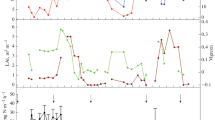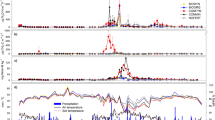Abstract
Understanding spatial variability of emissions of nitrous oxide (N2O) is essential to understanding of N2O emissions from soils to the atmosphere and in the design of statistically valid measurement programs to determine plot, farm and regional emission rates. Two afternoon, ‘snap-shot’ experiments were conducted; one in the summer and one in the autumn of 2004, to examine the statistics and soil variables affecting the spatial variability of N2O emissions at paddock scale. Small, static chambers (mini-chambers) were placed at 100 locations over an 8,100 m2 area of irrigated dairy pasture in northern Victoria, Australia. Chamber headspace was sampled for N2O and soil samples taken below each mini-chamber were analysed for soil nitrate (NO3 -), ammonium (NH4 +) and other chemical and physical properties known to affect N2O emissions. The experiments took place immediately after the sequence of grazing, urea application and irrigation. Nitrous oxide emissions and soil variables were analysed using classical statistics to investigate the effect of soil variables on N2O emissions. Geostatistics were used to investigate spatial patterns of N2O emissions and soil variables over the measurement area. Nitrous oxide emissions were extremely variable; 45–765 ng N2O–N m−2 s−1 and 20–953 ng N2O–N m−2 s−1 for the two experiments with corresponding averages of 165 and 138 ng N2O–N m−2 s−1. Nitrous oxide emissions showed spatial dependence up to 73 and 51 m for the two experiments. Nitrous oxide emissions showed significant correlation with soil nutrients in decreasing order of NO3 -, NH4 + and available-P concentrations. There was no significant correlation of N2O emissions with measured soil physical properties.







Similar content being viewed by others
References
AGO (2002) N.G.G.I. National Greenhouse Gas Inventory. Australian Greenhouse Office, Canberra, Australia
Ambus P, Christensen S (1994) Measurement of N2O emission from a fertilized grassland: an analysis of spatial variability. J Geophys Res (Atmospheres) 99:16557–16567
Aulakh MS, Doran JW, Mosier AR (1992) Soil denitrification: significance, measurement, and effects on management. In: Stewart BA (ed) Advances in soil science. Springer, New York, USA, pp 2–57
Ball BC, Horgan GW, Clayton H, Parker JP (1997) Spatial variability of nitrous oxide fluxes and controlling soil and topographic properties. J Environ Qual 26:1399–1409
Ball BC, Horgan GW, Parker JP (2000) Short-range spatial variation of nitrous oxide fluxes in relation to compaction and straw residues. Eur J Soil Sci 51:607–616
Choudhary MA, Akramkhanov A, Saggar S (2002) Nitrous oxide emissions from a New Zealand cropped soil: tillage effects, spatial and seasonal variability. Agric Ecosyst Environ 93:33–43
Clark I, Harper W (2000) Practical geostatistics. Geostokos (Ecosse), Alloa, Scotland
Dalal RC, Wang WJ, Robertson GP, Parton WJ (2003) Nitrous oxide emission from Australian agricultural lands and mitigation options: a review. Aust J Soil Res 41:165–195
ESRI (2005) ArcMap. ESRI, Redlands, CA, USA
FAO (2001) Chapter 3: measurement techniques. In: Global estimates of gaseous emissions of NH3, NO and N2O from agricultural land. Food and Agriculture Organization of the United Nations, Rome
Firestone MK (1982) Biological denitrification. In: Stevenson FJ (ed) Nitrogen in agricultural soils. ASA, CSSA, SSSA, Madison, pp 289–318
Folorunso OA, Rolston DE (1984) Spatial variability of field-measured denitrification gas fluxes. Soil Sci Soc Am J 48:1214–1219
Gamma Design Software (2006) GS+. Gamma design software. Plainwell, MI, USA
IPCC (2001) Climate change 2001: synthesis report. Intergovernmental Panel on Climate Change, Geneva, Switzerland
Isbell RF (2002) The Australian soil classification. CSIRO, Collingwood, Australia
Ishizuka S, Iswandi A, Nakajima Y, Yonemura S, Sudo S, Tsuruta H, Muriyarso D (2005) Spatial patterns of greenhouse gas emission in a tropical rainforest in Indonesia. Nutr Cycl Agroecosyst 71:55–62
Langenfelds RL, Steele LP, Schoot MVVd, Cooper LN, Spencer DA, Krumme PB (2004) Atmospheric methane, carbon dioxide, hydrogen, carbon monoxide and nitrous oxide from Cape Grim flask air samples analysed by gas chromatography. In: Cainey JM, Derek N, Krummel PB (eds) Baseline atmospheric program Australia. Bureau of meteorology and CSIRO atmospheric research, Melbourne, pp 46–47
Linn DM, Doran JW (1984) Effect of water-filled pore space on carbon dioxide and nitrous oxide production in tilled and nontilled soils. Soil Sci Soc Am J 48:1267–1272
Manning MR, Pearman GI, Etheridge DM, Fraser PJ, Lowe DC, Steele LP (1996) The changing composition of the atmosphere. In: Bouma WJ, Pearman GI, Manning MR (eds) Greenhouse: coping with climate change. CSIRO Australia, Melbourne, p 682
MINITAB Inc (2003) Minitab statistical software, release 14 for Windows. Minitab Inc., State College, Pennsylvania, USA
Mosier AR, Doran JW, Freney JR (2002) Managing soil denitrification. J Soil Water Conserv 57:505–513
Mulvaney RL (1996) Nitrogen—inorganic forms. In: Sparks DL (ed) Methods of soil analysis. Soil Science Society of America, Madison, pp 1123–1185
Nelson DW, Sommers LE (1982) Total carbon, organic carbon, and organic matter. In: Page AL, Miller RH, Keeney DR (eds) Methods of soil analysis part 2: chemical and microbial properties. ASA, SSSA, Madison, USA, pp 539–580
Parkin TB (1987) Soil microsites as a source of denitrification variability. Soil Sci Soc Am J 51:1194–1199
Pennock DJ, Vankessel C, Farrell RE, Sutherland RA (1992) Landscape-scale variations in denitrification. Soil Sci Soc Am J 56:770–776
Phillips FA, Leuning R, Baigent R, Kelly K, Denmead OT (2007) Nitrous oxide fluxes measurements from an intensively managed irrigated pasture using micrometeorological techniques. Agric Meteorol 143:92–105
Rayment G, Higginson F (1992) Australian laboratory handbook of soil and water chemical methods. Inkata, Melbourne
Rover M, Heinemeyer O, Munch JC, Kaiser E-A (1999) Spatial heterogeneity within the plough layer: high variability of N2O emission rates. Soil Biol Biochem 31:167–173
Velthof GL, Jarvis SC, Stein A, Allen AG, Oenema O (1996) Spatial variability of nitrous oxide fluxes in mown and grazed grasslands on a poorly drained clay soil. Soil Biol Biochem 28:1215–1225
Velthof GL, van Groenigen JW, Gebauer G, Pietrzak S, Jarvis SC, Pinto M, Corre W, Oenema O (2000) Temporal stability of spatial patterns of nitrous oxide fluxes from sloping grassland. J Environ Qual 29:1397–1407
Whitehead DC (1995) Amounts, sources and fractionation of organic nitrogen in soils. In Grassland nitrogen. CAB International, Oxon, UK, pp 82–107
Wrage N, Velthof GL, Laanbroek HJ, Oenema O (2004) Nitrous oxide production in grassland soils: assessing the contribution of nitrifier denitrification. Soil Biol Biochem 36:229–236
Yanai J, Sawamoto T, Oe T, Kusa K, Yamakawa K, Sakamoto K, Naganawa T, Inubushi K, Hatano R, Kosaki T (2003) Atmospheric pollutants and trace gases: spatial variability of nitrous oxide emissions and their soil-related determining factors in an agricultural field. J Environ Qual 32:1965–1977
Acknowledgement
The author acknowledges all those who helped on the project including, but not exclusively, Graeme Phyland, Emma Turner, Jenny Chen, Gary Clark, Guang Lu Zhang and Cameron Kelly. This study was a joint contribution of The Cooperative Research Centre for Greenhouse Accounting, Australia. The author is grateful for an Australian Commonwealth Scientific and Industrial Research Organisation (CSIRO) postgraduate award and the financial support from the Cooperative Research Centre for Greenhouse Accounting, Australia.
Author information
Authors and Affiliations
Corresponding author
Additional information
Responsibile Editor: Klaus Butterbach-Bahl.
Rights and permissions
About this article
Cite this article
Turner, D.A., Chen, D., Galbally, I.E. et al. Spatial variability of nitrous oxide emissions from an Australian irrigated dairy pasture. Plant Soil 309, 77–88 (2008). https://doi.org/10.1007/s11104-008-9639-8
Received:
Accepted:
Published:
Issue Date:
DOI: https://doi.org/10.1007/s11104-008-9639-8




